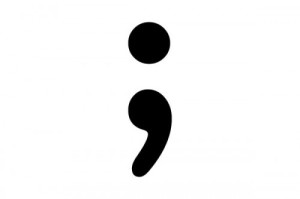A while back I posted about semicolons and how much I dislike them. Ever since, it seems they’ve been taunting me as they pop up in people’s posts, even my own, and overused in books. I thought I might try to learn to appreciate them, albeit reluctantly, but it’s still a work-in-progress.
I’ve never really cared for the suckers, but imagine my surprise when I was reading Spunk & Bite and came upon the chapter titled The Art of the Semicolon. Again, I say, they are taunting me.
I had been reading the book for a while but when I came upon this chapter, I set aside the book for months. I didn’t care about the mark and knew I couldn’t get into this article. And maybe I wouldn’t have appreciated it at the time I set the book down, which is why I picked it back up now.
I had forgotten about the book, saw it one day (in the bathroom), and picked it up to open it at the bookmark. And, because semicolons had been on my mind a lot lately, I decided to see what this author had to say.
I’ll start off my saying that I’ve never liked semicolons. Anyone who knows me well knows that. So when an editor blasted my book with semicolons, I cringed and went on something of a … well, panic attack. If you ask the author of Spunk and Bite, he might tell you that some would say it’s because I don’t understand them. “I exist, ergo, figure me out” he says of semicolons.
But I do; I do understand them; I just don’t like them.
This chapter gave me a new appreciation of this dreaded punctuation mark. He talked of its history and spoke of long-ago authors. Dickens loved them and Twain made ample use of them. Then he spoke of how some authors overuse them. Yes, thank you thank you, I agree with that. After all before I (somewhat) learned to appreciate them, one was too much in my book.
Arthur Plotnik of Spunk and Bite calls the semicolon an art. Although I wouldn’t name it as art, I couldn’t have said his words better myself. Yes, the semicolon has grammatical rules, but they are often overlooked nowadays. I know some who would say only fools overlook them, but to each his own. I believe, as this author believes, that the semicolon should be used as “certain nuances felt by the writer, certain gestures and whispered messages.”
“With the semicolon, there is a split second tease,” Arthur Plotnik says.
I love how Arthur Plotnik describes them as this: “How do I want to orchestrate the sense and cadence of my writing?”
To me, semicolons aren’t about being grammatically correct. They are about constructing your words, your sentence, your story, just as this author describes. And, like anything, they can be overused.
You can use semicolons to orchestrate your writing. Use can use them to act as mortar, a separator, expression, or clarity. In my opinion, of course, you wouldn’t want to overuse them, even to separate two separate sentences where a period could be used, unless the novel calls for it. It’s not about the sentence or the grammar, but about the novel as a whole.
And I say of a semicolon: to thine own self; be true.


This post made me laugh because I know that I’ve been an over-user of the semicolon here lately. I love how eloquently you’ve explained it through Arthur Plontnik’s view. It makes it sound like using the semicolon is such a beautiful and unique way to elaborate whatever you’re writing, when it’s not being misused of course 🙂